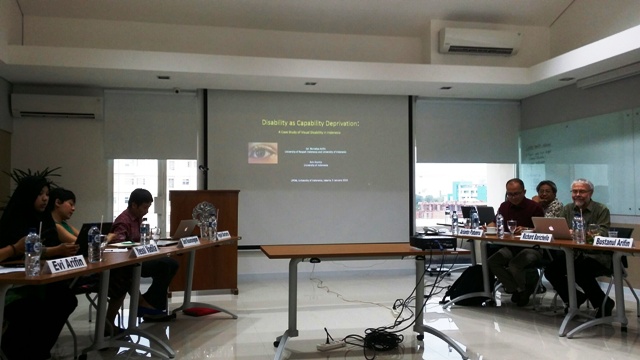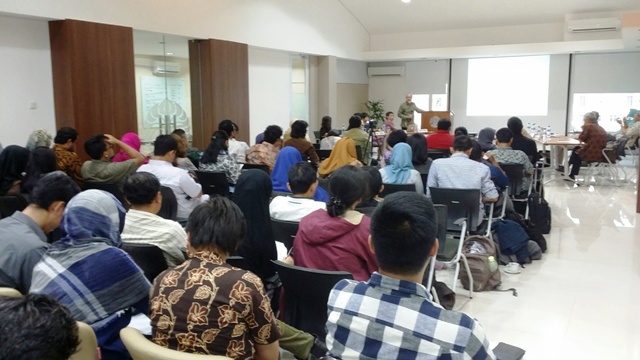The ANU Indonesia Project hosted the FKP in January 2017. The first FKP seminar of the year was held on 5 January 2017 at LPEM FEB UI, Jakarta with the topic Trade, poverty and income distribution: the Indonesian experience. The seminar delivered expanded topics of trade, poverty, and income inequality through different perspectives. More than seventy people attended the event.
In his introduction to the seminar, Richard Barichello (University of British Columbia) stated that the issue of trade and its relation to poverty and income inequality was important to Indonesia, a country which has been enjoying declining poverty rate and relatively ‘good’ economic growth. On the other hand, more trade is seen as one of the impetus for the increase of income inequality in Indonesia.
There were seven papers being presented in the seminar, three of which tried to answer fairly similar question related to trade and income inequality: “The Impact of Trade Expansion on Poverty and Income Inequality in Indonesia” (Teguh Dartanto, Y. Sofiyandi & N. Solihah), “Does Globalization Induce Income Inequality?” (Yessi Vadila & Budy Resosudarmo), and “Is Greater Openness to Trade Good: What Are the Effects on Poverty and Inequality?” (Arianto Patunru & T. M. Zakir Machmud).
Teguh Dartanto (LPEM FEB UI) explained that the speed of poverty reduction in Indonesia has begun to slow down with inequality continuing to rise significantly, while at same period the exposure of regional economies in Indonesia to international market is increasing. Similar empirical evidence is also observed by Yessi Vadila (Indonesia Ministry of Trade). She particularly noticed that the phenomenon occurring in Indonesia is contradictive to Hecksher-Ohlin Theorem, which states that trade liberalization could reduce income inequality amongst capital owner and labor. Yessi regressed provincial Gini coefficient from the year of 2000 to 2010 against provincial Foreign Direct Investment (FDI) ratio and trade openness, while Teguh used trade openness as the regressor for poverty, income inequality, and economic growth. The results from the two studies are quite similar. Both studies show provinces that were more open to the international trade have higher income inequality rate. Another result is that FDI could reduce poverty rate. However, unbalanced FDI to GDP ratio contributes to the income inequality instead. As the final remark, Teguh concluded that trade openness cannot stand alone, there should be also socio-economic development to address income inequality problem, such as building more infrastructures and greater access to infrastructure.
Slightly different but still related to the first two papers, Arianto Patunru (ANU Indonesia Project) embarked from the fact that Indonesia’s participation in the global market is relatively small as there are considerable amount of hindrances in the form of non-tariff barriers. He takes rice as the main subject, considering Indonesia status as the biggest rice consumer in Southeast Asia and the fifth largest rice importer in the world. On top of that, domestic rice prices have been increasing constantly and experiencing 60% of deviation from the world prices. Contrary to the common belief, rice as a commodity gives only a small portion of employment since there is a shift of labor force to other sectors. Moreover, the majority of rural rice consumers in Indonesia are living below the poverty line. It raises a question: who benefits from trade restrictions? The study did a simulation by increasing rice price by 5%. The net effect is negative. Both rural and urban rice consumers could suffer loss from increasing rice prices, particularly those who are in lower income group. It also hurts rice farmers in Indonesia since most of them are net-consumers. Hence, trade restriction in commodities such as rice is bad for the poor.
Still related to agricultural sector, Bustanul Arifin (Universitas Lampung) presented his study on “Coffee Eco-Certification: New Challenges for Farmer’s Welfare”. Despite the fact that Indonesia ranked third or fourth as a largest coffee producer in the world, regions producing coffee in Indonesia are among the poorest. That is induced by low level of price transmission, meaning that high price of coffee in the market does not guarantee that the farmers also receive high profit. With the growing urban coffee consumers, farmers have chance to improve their welfare. In addition, there is also growing interest in sustainability certification for commodities including coffee. A previous study by Bustanul Arifin in 2014 showed that participation in coffee certification could improve farmers’ income and environmental benefits. Nonetheless, many of them are still not aware of the differences between the certification schemes. The study suggests that there should be assistance program for farmers related to technical assistance, better farming practices, and empowerment actions in order to prepare them for integration to the global market.
While the two studies discussing trade and commodities, Richard Barichello associated trade with Indonesian labor market in “Reducing Rural Poverty through Trade: Evidence from Indonesia”. Rural regions have the lowest incomes in all countries and the poorest people have only their labor to sell. Thus, agricultural or rural labor market is crucial to deal with poverty reduction. By this, raising agricultural wage rates will reduce poverty in rural regions. The study tries to analyze the determinant of wage rates in rural regions and its relation with urban labor market, in view of relatively high level of migration in Indonesia. Using data from the year of 1983-2009 in West, Central, and East Java, long-run equilibrium analysis conducted in the study finds that manufacturing wage rate is the most significant factor in determining the agricultural wage rates while rice price has a much smaller effect. In other words, agricultural wage rates in Indonesia are influenced mostly by non-farm factors, only modestly affected by farm prices. Therefore, raising rice price may have limited effect on rural wages in the long run. It is important then to keep non-agricultural economy growing, the non-agricultural wage rate rising, and for agricultural and rural labor to have the necessary education levels to compete in the non-agricultural labor market.
Putting topic of trade aside, Aris Ananta and Evi Arifin (both of Lembaga Demografi, FEB UI) brought up a topic of disability and poverty in “Disability as Capability Deprivation: A Case Study of Visual Disability in Indonesia”. The reason to specifically raise the issue of visual disability is that eye health is becoming more important in today’s digital world and eye disease is easier and cheaper to avoid. One of Indonesia’s responses to visual disability is by releasing a more detailed disability data and statistics through National Socio-Economic Survey (Survei Sosio-Ekonomi Nasional or SUSENAS) started from 2010. There were 5.8 million persons with visual impairment including 8.7% of them suffering from severe impairment. Distribution of visual impairment is concentrated in prime adult population (workforce), which is a serious problem for the quality of Indonesian labors. The prevalence of visual impairment follows a J-shaped curve: probability of visual impairment is increasing as a person getting older. Such phenomenon is also worth to concern given the rising ageing population in Indonesia.
Lastly, Santi Kusumaningrum (Columbia University) presented her study regarding children’s wellbeing in collaboration with Arianto Patunru. The study concern is poverty and income inequality affecting Indonesian children since there are around 23.4 million children live in poor families. Santi argues that Indonesia’s demographic trend can only turn into a real bonus when the resources are allocated to tackle and prevent long-term consequences of childhood adversities. There is an on-going conditional cash transfer program called Program Keluarga Harapan (PKH) that already showed positive results: consumption of PKH family has improved around 14% and significant to increase pre-natal visit, immunization, and reduction of stunting. Santi also argues that poverty reduction and social protection strategies should prioritize inclusivity. To achieve that, the government needs to improve birth registration performance to facilitate better access to basic facilities, more responsive planning and budgeting, and accurate vital statistics. It is necessary to conduct longitudinal research that investigates children’s exposure to adversity. Expanding initiatives such as PKH, combining financing and psychosocial help could also lead to better outcomes for children at risk.

